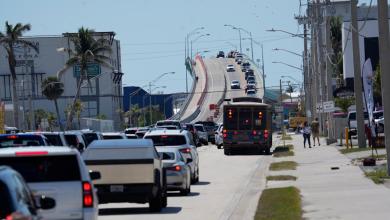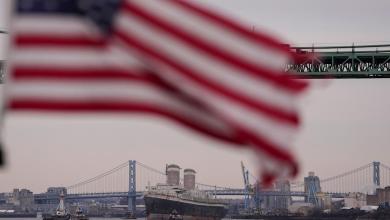Is the Blue Ridge Parkway open? 10 things to know before your spring parkway drive
ASHEVILLE – Almost six months after Tropical Storm Helene hit Western North Carolina, some major regional attractions remain closed or only partially open. The Blue Ridge Parkway, the nation’s second most visited national park unit, is one of those popular attractions.
As spring arrives and cars begin to fill the 469-mile parkway that spans the Blue Ridge Mountains from Shenandoah National Park in Virginia to the Great Smoky Mountains National Park in Cherokee, here are 10 things to know before you travel.
Photos provided by the National Park Service show landslide damage near milepost 348 along the Blue Ridge Parkway. Damage from Tropical Storm Helene is estimated to cost over $1 billion to repair.
Plan your visit, parkway only partially open
Of the parkway’s 469 miles, only 310 have reopened since the storm, according to the parkway’s website, meaning major sections are still closed to visitors. Closed sections from the storm include the following:
-
From milepost 217.3 near Cumberland Knob Trail to Milepost 285.5 near the Parkway Cabins.
-
Milepost 305.3 near Beacon Heights Overlook to Milepost 330.8 near Skyline Village Inn.
-
Milepost 333.9 near the Switzerland Inn to Milepost 381.9 near Asheville.
-
Milepost 393.8 near the French Broad Overlook to Milepost 405.4.
-
Milepost 420.3 near John Rock Trail to Milepost 423.3 near the Courthouse Valley Overlook.
Parkway visitors can check the status of sections of the parkway at https://www.nps.gov/blri/planyourvisit/conditions.htm. Visitors are encouraged to share their plans with others in advance.
A map of the sections of the Blue Ridge Parkway where emergency repair and recovery work is underway as of February 2025. The map does not represent all areas where damaged occurred.
Open in Virginia
Pending other non-Helene related closures, the parkway’s 217 miles in Virginia are entirely open for visitors to drive on, according to the parkway’s website. Normal traffic has resumed in the state’s section of the parkway since the storm, leaving a major portion of the parkway open for public travel.
Some iconic sections are still open
While portions of the parkway are closed, some iconic and well-traveled sections remain open. The Linn Cove Viaduct, near Grandfather Mountain, is open for public travel, though the parkway is closed after Beacon Heights Overlook near mile marker 305.
The Blue Ridge Parkway’s iconic Linn Cove Viaduct weaves around Grandfather Mountain as the sunset casts the area’s resplendent fall color in evening light in this 2021 Citizen Times file photo.
2024 parkway visitation high
Over 16.7 million people visited the parkway in 2024, making it the second most visited national park unit in the country, according to National Park Service visitation data.
Modifications to National Park Service visitation data increased the estimated number of visitors on the parkway during the early months of 2024, parkway spokesperson Leesa Brandon told the Citizen Times March 11. Due to those modifications, the parkway saw a similar number of visitors as recorded in 2023 despite Helene.
$1.4 billion in visitor spending
Parkway visitors spend around $1.4 billion across the communities along the road, including Asheville, where the parkway is headquarted, according to a 2023 park service report. The parkway is estimated to support around 19,200 jobs and its total estimated economic impact is $1.8 billion.
Helene’s wind and rain
In some areas along the parkway, Helene dumped 30 inches of rain, leading to landslides and flooding damage to several visitor sites, according to the parkway’s website. Along the parkway, near Mount Mitchell State Park, the National Weather Service recorded winds of over 100 mph, according to a November Facebook post from the agency.
Impact of landslides
Helene caused 57 landslides to the parkway, Superintendent Tracy Swartout told a crowd at a Feb. 12 event hosted by the Buncombe County Tourism Development Authority. Over four dozen of those landslides were recorded between Linville Falls near milepost 317 to Mount Mitchell State Park near milepost 349. Landslides were recorded across 200 miles of the parkway.
Photos provided by the National Park Service show the damage that resulted in a “complete loss” of the Linville Falls Visitor Center along the Blue Ridge Parkway, near Milepost 317.
Linville Falls Visitor Site “complete loss,” years to reopen
One of the sections closed by Helene is the Linville Falls Visitor Center, which was considered a “complete loss” after Helene, according to the park service. This section of the parkway will not open in 2025.
Some sections of the parkway will take “two to three years,” to recover from the storm, Swartout told the Citizen Times in February.
Over $1 billion for repairs
The estimated cost to repair the parkway is between $1 billion and $2 billion, Swartout said. The park has already received $25 million in funding from the U.S. Department of Transportation’s Federal Highway Administration emergency relief funds. Contracts for some repair work have been awarded, and emergency repairs are expected to “continue across the summer,” according to the Blue Ridge Parkway’s website.
The National Park Service has received $2.3 billion in supplemental disaster recovery funding from Congress, according to a December news release from North Carolina Sen. Thom Tillis. Nearly $1.7 billion would be used to rebuild the parkway, his office said at the time.
In December, the North Carolina Office of State Budget and Management estimated it would cost $18 million per mile of new lane construction to repair the parkway. The office does not have official damage estimates for the park service.
Will Hofmann is the Growth and Development Reporter for the Asheville Citizen Times, part of the USA Today Network. Got a tip? Email him at WHofmann@citizentimes.com. Consider supporting this type of journalism with a subscription to the Citizen Times.
This article originally appeared on Asheville Citizen Times: Is the Blue Ridge Parkway open? 10 things to know before visiting
Source link


